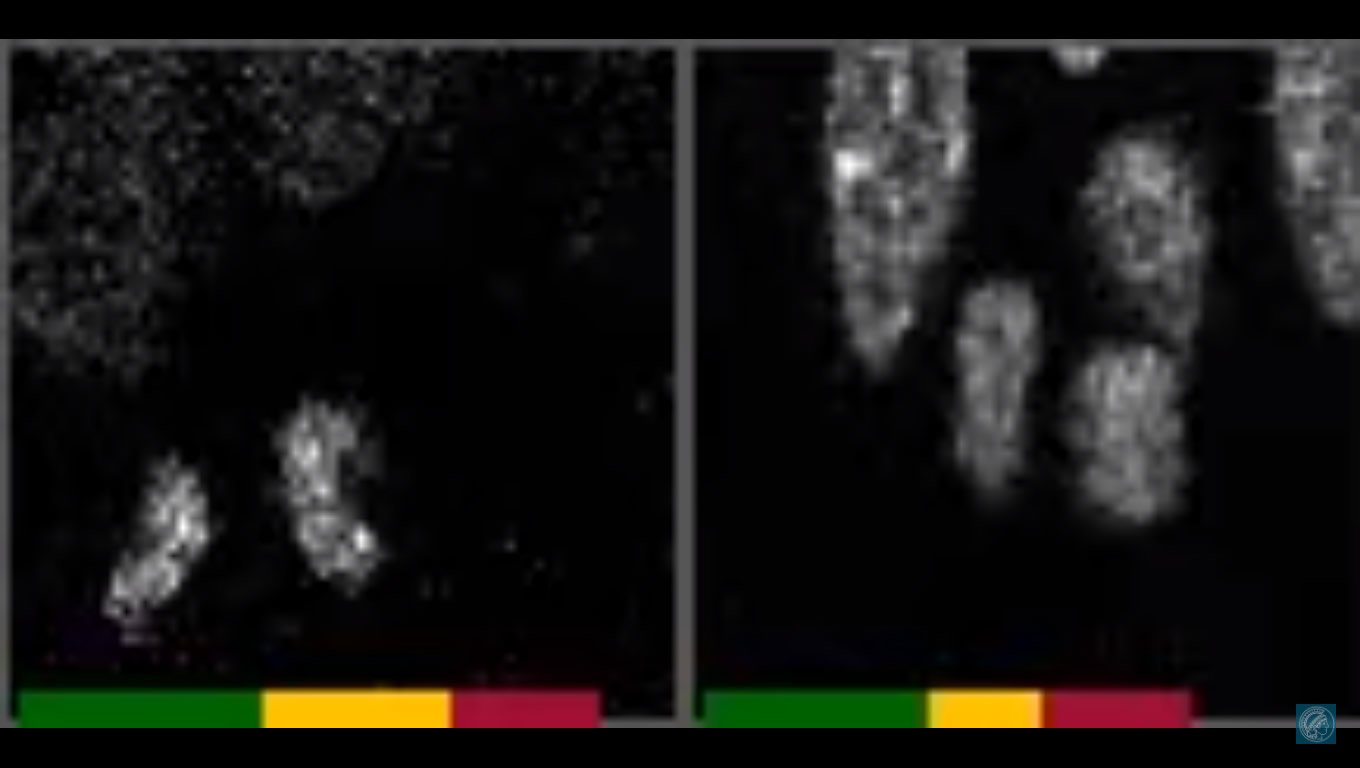Summary: A new study reports stem cells in the human brain take more time to arrange the chromosomes before distribution than stem cells of great apes.
Source: Max Planck Institute.
Stem cells in the human brain take more time to arrange the chromosomes before distribution than stem cells of great apes.
Our similarities and differences to chimpanzees, our great ape cousins, have intrigued people for centuries. Of particular interest is the brain. Scientists at the Max Planck Institute of Molecular Cell Biology and Genetics in Dresden and the Max Planck Institute for Evolutionary Anthropology in Leipzig now report the first detailed comparison of how human and chimpanzee stem cells form a cerebral cortex during brain development. They uncover a subtle but intriguing difference in how the cortical stem cells divide – the human cells take more time to arrange the chromosomes before they are distributed to the daughter cells. This may help to understand why human and chimpanzee brains develop differently.
The team of researchers from the groups of Wieland Huttner at the Max Planck Institute of Molecular Cell Biology and Genetics and Svante Pääbo and Barbara Treutlein at the Max Planck Institute for Evolutionary Anthropology first reprogrammed ape white blood cells to become induced pluripotent stem cells (iPSCs). Then they used these cells as well as human iPSCs to grow cerebral organoids, tissue structures that resemble developing brain tissue. The brain stem cells from ape and human organoids were very similar to each other in terms of the subtypes of stem cells formed, their gene expression, and how they divide.

Surprisingly, however, the duration of one phase of the cell division process, as revealed by imaging of brain stem cells in the living cerebral organoids, was different between humans, chimpanzees and orangutan. Specifically, the duration of metaphase, when the chromosomes line up before division, was around 50% longer in humans. “We think this difference could indicate that human brain stem cells have a higher proliferation capacity than those of chimpanzee. In brain stem cells that tend to proliferate, this phase was longer than in those that tend to generate neurons” says lead author Felipe Mora-Bermúdez who made these observations. The next step will be to investigate the link between metaphase length and brain stem cell proliferation vs. differentiation further.
Comparative time-lapse movies of a brain stem cell division in cerebral organoids from human (left) and chimpanzee (right). The growing colour bars at the bottom indicate time progression of the respective dividing cells and are synchronized to the beginning of prometaphase (in green); the metaphase plate time, which is longer in human than chimpanzee, is in yellow, and anaphase time is in red.
The researchers also found that human cerebral organoids contain a higher proportion of proliferative cortical stem cells than chimpanzee organoids, and gene expression differences between the species also hinted that proliferation capacity differs between the species. “The subtle but intriguing differences we have found at the cellular and molecular level may play important roles in the evolution of the human brain” concludes Wieland Huttner, who supervised the study. The researches will now focus on investigating the mechanisms and implications of these differences.
Source: Wieland B. Huttner – Max Planck Institute
Image Source: NeuroscienceNews.com image is adapted from the Max Plank Institute video.
Video Source: The video is credited to Max Planck Institute.
Original Research: Abstract for “Differences and similarities between human and chimpanzee neural progenitors during cerebral cortex development” by Felipe Mora-Bermúdez, Farhath Badsha, Sabina Kanton, J. Gray Camp, Benjamin Vernot, Kathrin Köhler, Birger Voigt, Keisuke Okita, Tomislav Maricic, Zhisong He, Robert Lachmann, Svante Pääbo, Barbara Treutlein and Wieland B. Huttner in eLife. Published online September 26 2016 doi:10.7554/eLife.18683
[cbtabs][cbtab title=”MLA”]Max Planck Institute. “Differing Division Rates of Brain Stem Cells.” NeuroscienceNews. NeuroscienceNews, 6 October 2016.
<https://neurosciencenews.com/neural-stem-cell-division-5229/>.[/cbtab][cbtab title=”APA”]Max Planck Institute. (2016, October 6). Differing Division Rates of Brain Stem Cells. NeuroscienceNews. Retrieved October 6, 2016 from https://neurosciencenews.com/neural-stem-cell-division-5229/[/cbtab][cbtab title=”Chicago”]Max Planck Institute. “Differing Division Rates of Brain Stem Cells.” https://neurosciencenews.com/neural-stem-cell-division-5229/ (accessed October 6, 2016).[/cbtab][/cbtabs]
Abstract
Differences and similarities between human and chimpanzee neural progenitors during cerebral cortex development
Human neocortex expansion likely contributed to the remarkable cognitive abilities of humans. This expansion is thought to primarily reflect differences in proliferation versus differentiation of neural progenitors during cortical development. Here, we have searched for such differences by analysing cerebral organoids from human and chimpanzees using immunohistochemistry, live imaging, and single-cell transcriptomics. We find that the cytoarchitecture, cell type composition, and neurogenic gene expression programs of humans and chimpanzees are remarkably similar. Notably, however, live imaging of apical progenitor mitosis uncovered a lengthening of prometaphase-metaphase in humans compared to chimpanzees that is specific to proliferating progenitors and not observed in non-neural cells. Consistent with this, the small set of genes more highly expressed in human apical progenitors points to increased proliferative capacity, and the proportion of neurogenic basal progenitors is lower in humans. These subtle differences in cortical progenitors between humans and chimpanzees may have consequences for human neocortex evolution.
“Differences and similarities between human and chimpanzee neural progenitors during cerebral cortex development” by Felipe Mora-Bermúdez, Farhath Badsha, Sabina Kanton, J. Gray Camp, Benjamin Vernot, Kathrin Köhler, Birger Voigt, Keisuke Okita, Tomislav Maricic, Zhisong He, Robert Lachmann, Svante Pääbo, Barbara Treutlein and Wieland B. Huttner in eLife. Published online September 26 2016 doi:10.7554/eLife.18683






